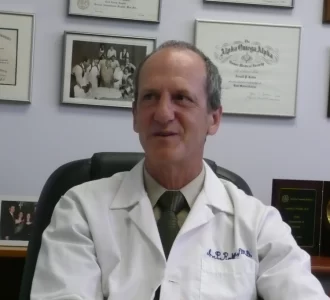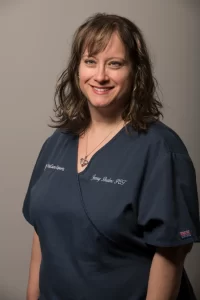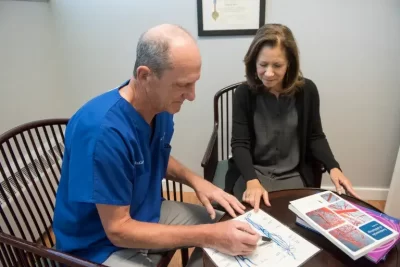Conditions
As phlebologists, we evaluate and treat many conditions associated with the venous and lymphatic systems. The majority of our patients are seeking help for varicose veins and chronic venous insufficiency. Varicose veins and chronic venous insufficiency are very common and not usually associated with more serious health issues. In fact, it is estimated that up to forty percent of the U.S. adult population has some sort of vein issue. Varicose veins may be a cosmetic problem, an annoyance, or a more serious medical problem limiting normal daily activities and the ability to lead a healthy active lifestyle. They also may lead to more serious issues such as swelling, blood clots, phlebitis, skin changes, bleeding, and leg ulcers.
Function and Structure of Veins
Many of our patients are concerned that they suffer from “poor circulation”. While lower extremity veins are part of the circulatory system, arterial and venous function are distinctly different. Atherosclerosis and peripheral artery disease (PAD) concerns the arterial side and are unrelated to most common venous issues. Arteries are responsible for delivering blood and nutrients to the tissues. Veins return the blood from the tissues to the heart, and lymphatics act as a sort of scavenger system for tissue fluids.
This system depends on many factors to function normally. For the veins, there must be a path free of blockages and normal functioning valves. Calf muscles also serve as an additional “pump” to aid in return of venous blood. If any or all of these components are not functioning properly, excess pressure may build up on the venous side leading to chronic venous insufficiency (CVI) and its consequences. The lower extremities have interconnected systems of veins.
The deep veins represent the final common path back to the heart. This system may be impaired by partial or complete blockages, clots (DVT), congenital malformations, or primary valve dysfunction. These conditions are difficult to treat and fortunately less common than superficial venous insufficiency. The superficial system includes the saphenous system (truncal veins) and its branches or tributaries. Perforator veins connect the deep and superficial systems and communicating veins connect components of the superficial system. Most patients present with problems in the superficial system.
This system also may be impaired by blockages, clots (SVT), or congenital malformations, but primary valve dysfunction is the most common problem. Advances in our field have made treatment of these problems very effective and relatively simple and painless.
What are Varicose Veins?
Varicose veins are elongated, dilated, tortuous veins most often found in the lower extremities. They may vary greatly in size, location, configuration, and symptoms, Varicose veins directly associated with the saphenous system are called truncal. As abnormal veins are located closer to the skin, they may be referred to as reticular, venulectasia, or telangiectasia (spider veins).
Causes
Because of the human erect posture, gravity causes elevated hydrostatic pressure in the veins of our legs. Inside the tubular structure of our veins, flap valves prevent backward flow and direct the blood toward the heart. Valves may become ineffective due to damage to the valve itself or to the surrounding vein segment. When a valve is damaged, there is increased pressure on the valve below, making it more susceptible to damage and creating a cascade effect. A key valve occurs at the saphenofemoral junction where the saphenous vein meets the femoral vein at the groin or upper thigh. Many people with varicose veins have an inherited tendency toward weak valves. The condition is aggravated by several factors including aging, pregnancy, smoking, or chronic increased abdominal pressure associated with cough, constipation, or heavy lifting. Long periods of standing associated with certain occupations or activities may also play a role.
Symptoms
Most patients with varicose veins have some symptoms, but the severity varies greatly. Typical symptoms are heavy, tired legs, restless legs, burning, itching, tingling, and a deep aching or throbbing pain. Cramps and restless legs are also common. Symptoms are typically worse while standing or sitting for long periods and improved with leg elevation. Symptoms may also be worse in warm weather or during a woman’s menstrual period.
Complications of Venous Insufficiency
Aside from discomfort and appearance, venous insufficiency, if left untreated, can lead to more serious local complications such as swelling or edema, inflammatory skin changes and leg ulcers, superficial and deep vein thrombophlebitis, and hemorrhage or bleeding.
Other Conditions
Thrombophilia:
Some people have a genetic predisposition to abnormal clotting. Unexpected or recurrent clotting episodes, unusual patterns, or a family history should prompt the physician to consider blood tests for these conditions. Certain acquired conditions can also make one prone to abnormal clotting and these may be considered on an individual basis.
Deep Venous Insufficiency:
Sometimes, excess pressure in the venous system of the legs (ambulatory venous hypertension) is due to abnormalities in the deep system. This situation may occur primarily or as a result of prior episodes of clots with valve destruction (post-phlebitic syndrome). Compression is the mainstay of treatment of deep venous insufficiency although there are complex valve repair or transplant procedures which may he considered in rare cases.
Congenital Venous Malformation:
Sometimes in the developing embryo, the venous system does not form correctly resulting in congenital venous malformations. The proper management begins with recognition. Evaluation and workup may be more complex than usual, but these conditions are often treatable or at least manageable. They may also affect soft tissue and bones and may be associated with a birthmark called a port-wine stain. The best known is Klippel-Tranaunay or K-T syndrome.
DVT/PE:
Clots in the deep veins are a more serious issue and may spread to the blood vessels in the lungs (pulmonary embolus or PE) and may lead to post-phlebitic syndrome with leg swelling, skin changes, and even ulcers. Diagnosis is usually readily made with some ultrasound and sometimes blood tests, venography, and lung imaging tests. Depending on the duration, location, extent, and precipitating factors, treatment may consist of a combination of blood thinners or anticoagulation, compression, and sometimes clot dissolution or clot removal.
SVT:
Clot formation in the superficial veins of the lower extremity is called superficial venous thrombosis, and may present with warmth, tenderness, palpable cord, redness and swelling. Patients usually have varicose veins with stagnant flow and may have had a recent period of immobility such as lengthy travel or local trauma. Diagnosis is usually readily made with physical examination. Ultrasound should be performed to evaluate the extent and rule out associated clot in the deep veins. Underlying conditions such as hereditary thrombophilia or malignancy may make patients more prone but are rarely implicated, particularly in the absence of other signs or history. Treatment is primarily directed at the symptoms although anticoagulation, or blood thinners may be used in extensive cases.
Lymphedema:
Lymphedema is fluid retention and swelling of the tissues due to a compromised lymphatic system. The condition may be secondary to injury to or blockage of the lymphatic system from things such as tumors, surgery, radiation, accidental injury, or infection. The condition may also develop in the setting of long standing venous edema. More frequently, it is primary, with no apparent cause. Limbs with chronic lymphedema are at increased risk for infection. Lymphedema is categorized according to stage and grade, or severity. Primary lymphedema is also categorized based on time of onset, such as from birth or later in life. Although microsurgical, low level laser therapy, and suction assisted lipectomy techniques have been used in refractory cases, the mainstay of therapy is exercise and compression using garments, wraps and pumps.
Leg Ulcers:
Leg ulcers or sores may occur with long standing chronic venous insufficiency. Especially with todays minimally invasive techniques, the condition is readily treated. Initial treated is with exercise, leg elevation, compression, and topical wound care. Management is then directed at the cause of the chronic venous insufficiency.

At Vein Experts, our varicose vein specialists are experts in the evaluation and treatment of patients with varicose veins and related problems.
- Phone : 847-259-8226
- Address : 1365 Wiley Rd #149, Schaumburg, IL 60173, USA





